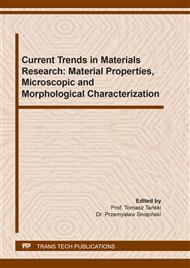[1]
P. Yu, S.E. Lowe, G.P. Simon, Y.L. Zhong, Electrochemical exfoliation of graphite and production of functional graphene, Curr. Opin. Colloid Interface Sci. 20 (2015) 329–338.
DOI: 10.1016/j.cocis.2015.10.007
Google Scholar
[2]
M. Galimberti, Rubber Clay Nanocomposites, Adv. Elastomers - Technol. Prop. Appl. (2012) 91–120.
Google Scholar
[3]
M. Chieruzzi, A. Miliozzi, J.M. Kenny, Effects of the nanoparticles on the thermal expansion and mechanical properties of unsaturated polyester/clay nanocomposites, Compos. Part A Appl. Sci. Manuf. 45 (2013) 44–48.
DOI: 10.1016/j.compositesa.2012.09.016
Google Scholar
[4]
P.G. Allison, R.D. Moser, M.Q. Chandler, O.G. Rivera, J.R. Goodwin, E.R. Gore, C.A.W. Jr, Mechanical , Thermal , and Microstructural Analysis of Polyvinyl Alcohol / Montmorillonite Nanocomposites, J. Nanomater. 2015 (2015).
DOI: 10.1155/2015/291248
Google Scholar
[5]
C. Vallés, A.M. Abdelkader, R.J. Young, I. a. Kinloch, Few layer graphene–polypropylene nanocomposites: the role of flake diameter, Faraday Discuss. 44 (2014) 379–390.
DOI: 10.1039/c4fd00112e
Google Scholar
[6]
J.R. Potts, D.R. Dreyer, C.W. Bielawski, R.S. Ruoff, Graphene-based polymer nanocomposites, Polymer (Guildf). 52 (2011) 5–25.
DOI: 10.1016/j.polymer.2010.11.042
Google Scholar
[7]
N. Follain, B. Alexandre, C. Chappey, L. Colasse, P. Médéric, S. Marais, Barrier properties of polyamide 12/montmorillonite nanocomposites: Effect of clay structure and mixing conditions, Compos. Sci. Technol. 136 (2016) 18–28.
DOI: 10.1016/j.compscitech.2016.09.023
Google Scholar
[8]
G. Gorrasi, M. Tortora, V. Vittoria, E. Pollet, B. Lepoittevin, M. Alexandre, P. Dubois, Vapor barrier properties of polycaprolactone montmorillonite nanocomposites: Effect of clay dispersion, Polymer (Guildf). 44 (2003) 2271–2279.
DOI: 10.1016/s0032-3861(03)00108-3
Google Scholar
[9]
G. Huang, S. Chen, H. Liang, X. Wang, J. Gao, Combination of graphene and montmorillonite reduces the flammability of poly(vinyl alcohol) nanocomposites, Appl. Clay Sci. 80–81 (2013) 433–437.
DOI: 10.1016/j.clay.2013.01.005
Google Scholar
[10]
M. Yadav, S. Ahmad, Montmorillonite/graphene oxide/chitosan composite: Synthesis, characterization and properties, Int. J. Biol. Macromol. 79 (2015) 923–933.
DOI: 10.1016/j.ijbiomac.2015.05.055
Google Scholar
[11]
H. Couderc, E. David, M. Frechette, S. Savoie, Dielectric properties of PA6 - Montmorillonite nanocomposites under moderate electric field, in: 2013 IEEE Electr. Insul. Conf. EIC 2013, 2013: p.291–294.
DOI: 10.1109/eic.2013.6554252
Google Scholar
[12]
Rashmi, N.M. Renukappa, R. Chikkakuntappa, N.S. Kunigal, Montmorillonite nanoclay filler effects on electrical conductivity, thermal and mechanical properties of epoxy-based nanocomposites, Polym. Eng. Sci. 51 (2011) 1827–1836.
DOI: 10.1002/pen.21974
Google Scholar
[13]
R.J. Sengwa, S. Choudhary, S. Sankhla, Dielectric properties of montmorillonite clay filled poly(vinyl alcohol)/poly(ethylene oxide) blend nanocomposites, Compos. Sci. Technol. 70 (2010) 1621–1627.
DOI: 10.1016/j.compscitech.2010.06.003
Google Scholar
[14]
P.-C. Ma, M.-Y. Liu, H. Zhang, S.-Q. Wang, R. Wang, K. Wang, Y.-K. Wong, B.-Z. Tang, S.-H. Hong, K.-W. Paik, J.-K. Kim, Enhanced Electrical Conductivity of Nanocomposites Containing Hybrid Fillers of Carbon Nanotubes and Carbon Black, ACS Appl. Mater. Interfaces. 1 (2009) 1090–1096.
DOI: 10.1021/am9000503
Google Scholar
[15]
A.A. Khurram, S.A. Rakha, P. Zhou, M. Shafi, A. Munir, Correlation of electrical conductivity, dielectric properties, microwave absorption, and matrix properties of composites filled with graphene nanoplatelets and carbon nanotubes, J. Appl. Phys. 118 (2015) 044105.
DOI: 10.1063/1.4927617
Google Scholar
[16]
H. Pang, C. Chen, Y. Bao, J. Chen, X. Ji, J. Lei, Z.M. Li, Electrically conductive carbon nanotube/ultrahigh molecular weight polyethylene composites with segregated and double percolated structure, Mater. Lett. 79 (2012) 96–99.
DOI: 10.1016/j.matlet.2012.03.111
Google Scholar
[17]
W. Park, J. Hu, L.A. Jauregui, X. Ruan, Y.P. Chen, Electrical and thermal conductivities of reduced graphene oxide/polystyrene composites, Appl. Phys. Lett. 104 (2014).
DOI: 10.1063/1.4869026
Google Scholar
[18]
D.K. Pradhan, R.N.P. Choudhary, B.K. Samantaray, Studies of dielectric relaxation and AC conductivity behavior of plasticized polymer nanocomposite electrolytes, Int. J. Electrochem. Sci. 3 (2008) 597–608.
Google Scholar
[19]
B.M. Greenhoe, M.K. Hassan, J.S. Wiggins, K.A. Mauritz, Universal power law behavior of the AC conductivity versus frequency of agglomerate morphologies in conductive carbon nanotube-reinforced epoxy networks, J. Polym. Sci. Part B Polym. Phys. 54 (2016) 1918–1923.
DOI: 10.1002/polb.24121
Google Scholar
[20]
M. Megdiche, C. Perrin-Pellegrino, M. Gargouri, Conduction mechanism study by overlapping large-polaron tunnelling model in SrNiP2O7 ceramic compound, J. Alloys Compd. 584 (2014) 209–215.
DOI: 10.1016/j.jallcom.2013.09.021
Google Scholar
[21]
A. Ladhar, M. Arous, H. Kaddami, M. Raihane, A. Kallel, M.P.F. Graça, L.C. Costa, AC and DC electrical conductivity in natural rubber/nanofibrillated cellulose nanocomposites, J. Mol. Liq. 209 (2015) 272–279.
DOI: 10.1016/j.molliq.2015.04.020
Google Scholar
[22]
M. Vellakkat, D. Hundekal, Electrical conductivity and supercapacitor properties of polyaniline/chitosan/nickel oxide honeycomb nanocomposite, J. Appl. Polym. Sci. 134 (2017).
DOI: 10.1002/app.44536
Google Scholar
[23]
O.G. Abdullah, Y.A.K. Salman, S.A. Saleem, Electrical conductivity and dielectric characteristics of in situ prepared PVA/HgS nanocomposite films, J. Mater. Sci. Mater. Electron. 27 (2016) 3591–3598.
DOI: 10.1007/s10854-015-4196-4
Google Scholar
[24]
A. Kahouli, A. Sylvestre, F. Jomni, B. Yangui, J. Legrand, Experimental and theoretical study of AC electrical conduction mechanisms of semicrystalline parylene C thin films, J. Phys. Chem. A. 116 (2012) 1051–1058.
DOI: 10.1021/jp207114u
Google Scholar
[25]
V. Kumar, T, A.S. Chary, S. Bhardwaj, A.M. Awasthi, S.N. Reddy, Dielectric Relaxation, Ionic Conduction and Complex Impedance Studies on NaNO3 Fast Ion Conductor, Int. J. Mater. Sci. Appl. 2 (2013) 173–178.
DOI: 10.11648/j.ijmsa.20130206.12
Google Scholar
[26]
I. Latif, T.B. Alwan, A.H. Al-Dujaili, Low Frequency Dielectric Study of PAPA-PVA-GR Nanocomposites, Nanosci. Nanotechnol. 2 (2012) 190–200.
DOI: 10.5923/j.nn.20120206.07
Google Scholar


